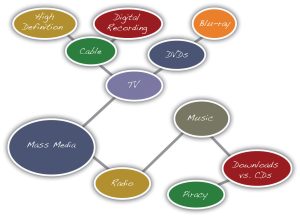Divergent Prewriting Strategies
One of the fundamental aspects of creative thinking is the interplay between divergent and convergent thinking. Divergent thinking refers to the process of collecting and generating as many ideas as possible. It’s exploratory and can be playful. Similar to freewriting, divergent prewriting techniques allow the write to roam free. The most commonly utilized divergent strategies are brainstorming and idea mapping.
Brainstorming
Brainstorming is similar to list making. You can make a list on your own or in a group with your classmates. Start with a blank sheet of paper (or a blank computer document) and write your general topic, issue, or debate questions across the top. Underneath your topic, make a list of related ideas or different responses to the question. Often you will find that one item can lead to the next, creating a flow of ideas that can help you narrow your focus to a more specific paper topic.
Exercise 2.2.1
On the same worksheet as you started above, including the purpose, audience, topic, and related questions, now add a table with one or two guiding questions at the top. Then, in the space beneath each question, jot down as many responses as possible, based on any research you’ve done so far, as well as your personal experiences, observations, and hunches.
My purpose: ____________________________________________
My audience: ____________________________________________
My topic: ____________________________________________
Related questions: ____________________________________________
Brainstorming List:
- [response 1]
- [response 2]
- [response 3]
- [response 4]
- [response 5]
In debate-driven assignments, such as an argument essay, the table might have two or three questions as the topic, corresponding to certain possible positions someone might take in response to an issue. The table should be adapted to your assignment needs.
Idea Mapping
Idea mapping allows you to visualize your ideas on paper using circles, lines, and arrows. This technique is also known as clustering because ideas are broken down and clustered, or grouped together. Many writers like this method because the shapes show how the ideas relate or connect, and writers can uncover unexpected connection. Using idea mapping, you might discover interesting connections between sources, ideas, other voices, and experiences that you had not thought of before.
To create an idea map, start with your general topic, guiding question or guiding in a circle in the center of a blank sheet of paper. Then write specific ideas around it and use lines or arrows to connect them together. Add and cluster as many ideas as you can think of.
The idea map example below is fairly basic. It begins with a general topic (mass media) and then expands into several different bubbles.

Notice the largest circle contains her general topic, mass media. Then, the general topic branches into two subtopics written in two smaller circles: television and radio. The subtopic television branches into even more specific topics: cable and DVDs. From there, the writer drew more circles and wrote more specific ideas: high definition and digital recording from cable and Blu-ray from DVDs. The radio topic led the student to draw connections between music, downloads versus CDs, and, finally, piracy.
From this idea map, the student saw they could consider narrowing the focus of her mass media topic to the more specific topic of music piracy.
Exercise 2.2.2
On the same worksheet as you started above, including the purpose, audience, topic, and related questions, now add space for an idea map, with your main topic, issue, or guiding question shown in the largest circle. From there, add as many circles as you can, based on any research you’ve done so far, as well as your personal experiences, observations, and hunches. Several free web apps are available for students to use as well, such as mindmup.com.
My purpose: ____________________________________________
My audience: ____________________________________________
My topic: ____________________________________________
Related questions: ____________________________________________
Idea Map:

